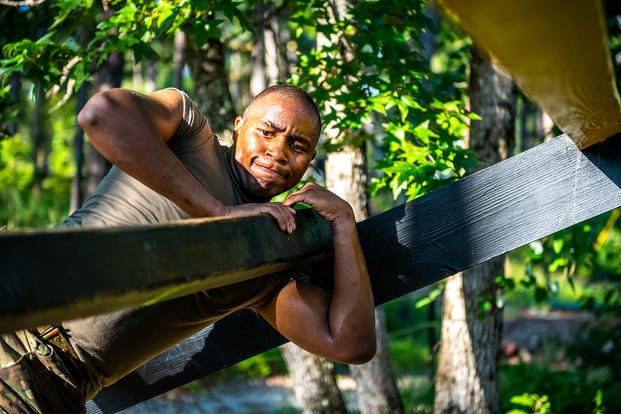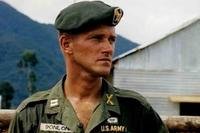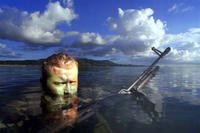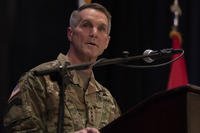Like all soldiers, Special Forces candidates begin their career with nine weeks of basic combat training (BCT). Upon completion of basic training, you will attend advanced individual training. For Special Forces, you will go to infantry school to learn to use small arms, anti-armor and weapons such as howitzers and heavy mortars. Before you can advance to the special operation career selection path, Special Forces candidates also much complete the Basic Airborne Course. For a complete timeline for the quickest an 18 XRAY candidate will attend SF training:
- Basic Combat Training lasts nine weeks
- AIT lasts four weeks
- Airborne last three weeks
All of these schools take place at Fort Moore, Georgia (formerly known as Fort Benning). Once you are an Airborne graduate, you will be authorized a permanent change of station (PCS) move to Fort Bragg, N.C. Here is where the Special Forces pipeline begins and ends for those seeking the Green Beret and special operations careers.
Special Forces Phase 1
Special Force Qualification Course Phase 1A is the preparation course where soldiers will check in, collect gear and start advanced-level physical training and land navigation. This phase (formerly known as SOPC I -- Special Operations Prep Course) is four weeks long.
Special Forces Qualification Course Phase 1B is the assessment and selection phase for Army Special Forces. Your motivation and desire will be challenged to see whether you are suitable for advanced Special Forces training. You will be tested and evaluated with psychological tests, fitness and swim tests, obstacle courses, long ruck marches and land navigation. After four weeks, soldiers will find out whether they are selected to attend the full Special Forces Qualification Course (SFQC), also known as the Q Course. This phase 1B is known formerly as SFAS -- Special Forces Assessment and Selection.
There is a short two-week course after advancing to Phase 2. The Special Forces Prep Course (SFPC) focuses on small-unit tactics and learn how to conduct raids, ambushes, recon and patrolling. This course gets all selected soldiers up to speed with many of the advanced-level tactics used in the Q Course. This prep course is known formerly as SOPC 2.
Special Forces Phase 2
Phase 2 combines small-unit tactics (SUT) and survival, evasion, resistance and escape (SERE) training. Soldiers will begin with more small-unit tactics on the squad and platoon levels and be tested in weapons marksmanship. The learning curve is steep in this five-week phase. After SUT, the next three weeks will focus on survival training, avoiding capture, resisting enemy interrogations and exploitations, and escaping captivity.
Phase 3
Depending upon the military occupational specialty, the soldier is selected to do the following jobs within the 12-man team known as the Special Forces Operations Detachment Alpha (ODA). The process of completing these schools can take 14-18 months.
You will receive MOS training for your Special Forces MOS, which includes SF critical tasks required for award of a career management field 18 military occupational specialty and interagency operations.
18B -- SF weapons sergeant -- 13 weeks. Students learn a large variety of American and foreign weapons systems from hand guns, rifles, anti-tank weapons, crewed served weapons and mortars.
18C -- SF engineer sergeant -- 13 weeks. Students who are engineer qualified become experts in building techniques, defensive fortifications, explosives, booby traps and land mines.
18D -- SF medical sergeant -- 46 weeks. The 18D education is arguably the best combat medic training in the world and creates experts in medical, surgical, dental, veterinary and pharmaceutical subjects. This course is called the Special Forces Medical Sergeants Course (SFMS), which consists of the 24-week Special Operations Combat Medic Course (SOCM) as well as an additional 22-week training cycle to complete the 18D training pipeline. Complete with trauma care, physiology, anatomy and advanced paramedic training.
18E -- SF communications sergeant -- 13 weeks. Students become experts not only in highly technical and advanced communication systems, but also the most basic forms of communications that are found in other countries. The entire bandwidth of communications is taught as well as cryptography and construction and repair of communications systems and antennas for all types of ground-to-ground and ground-to-air communications capabilities.
Phase 4
Language training -- Based on your language skills, you will advance through language and culture training to get ready to serve in the SF. Additionally, while receiving language training, you will be trained in warrior skills, such as combatives. This phase may take up to 18-24 weeks. The language opportunities of all Special Forces operators are Spanish, French, Portuguese, German, Indonesian, Czech, Persian-Farsi, Polish, Russian, Tagalog, Thai, Turkish, Arabic, Korean and Japanese.
Phase 5
The final phase is a culmination exercise known as Robin Sage, which is five weeks long and where students will form their own SFODA and put their training and experience of the last several months to the test. This is a realistic training setting, dealing with indigenous personnel, counterinsurgency and tested in the mission (foreign internal defense) of training a mock guerrilla force in a hostile environment.
After Robin Sage, the students are now members of the Special Forces community and have earned the Green Beret and the Oppresso De Libre ("Free the Oppressed") pin.
The new Special Forces soldiers soon will be shipped to their new duty stations -- Special Forces Groups (SFG). The options are the following:
1st SFG -- Joint Base Lewis-McChord, Washington
3rd SFG -- Fort Bragg, N.C.
5th SFG -- Fort Campbell, Kentucky
7th SFG -- Fort Bragg
10th SFG -- Fort Carson, Colorado
19th and 20th SFG are National Guard groups
*The 12-man ODA is comprised of the following members:
18A -- Commander (captain)
180A -- Executive officer (warrant officer)
18Z -- Operations NCO/team sergeant
18F -- Intelligence sergeant
18B -- Two weapons sergeants
18C -- Two engineer sergeants
18D -- Two combat medic sergeants
18E -- Two communications sergeants
Want to Know More About the Military?
Be sure to get the latest news about the U.S. military, as well as critical info about how to join and all the benefits of service. Subscribe to Military.com and receive customized updates delivered straight to your inbox.












